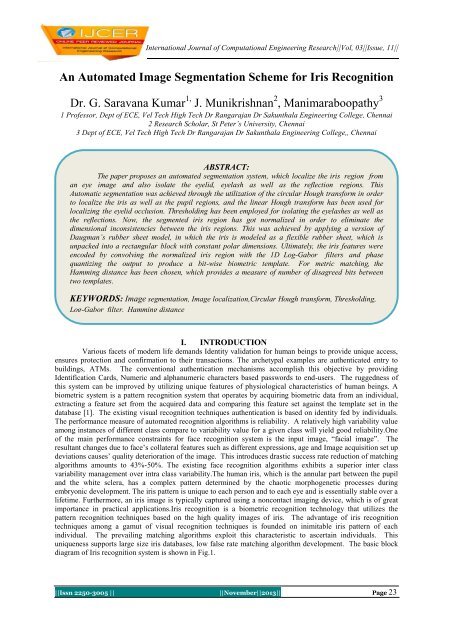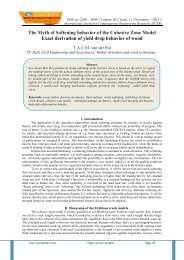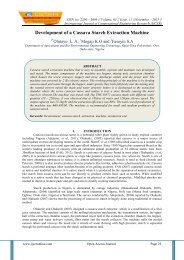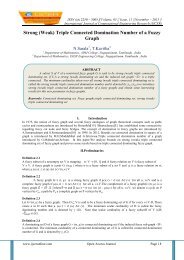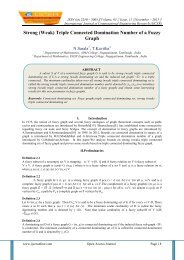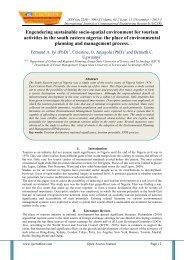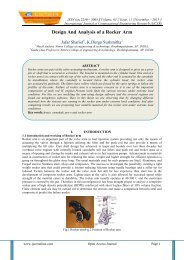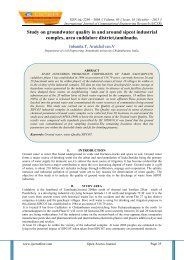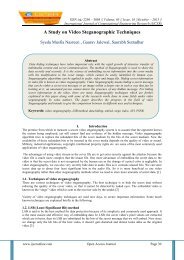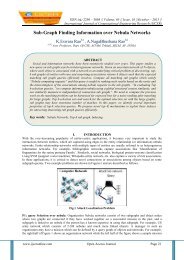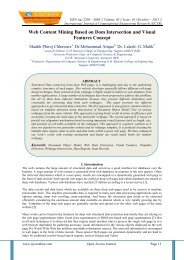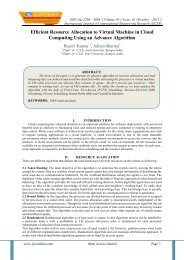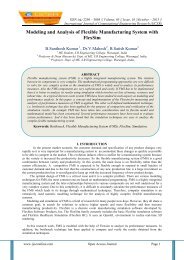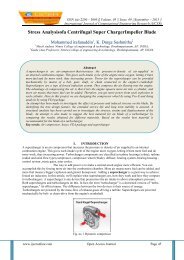D031102023030.pdf
International Journal of Computational Engineering Research(IJCER) is an intentional online Journal in English monthly publishing journal. This Journal publish original research work that contributes significantly to further the scientific knowledge in engineering and Technology.
International Journal of Computational Engineering Research(IJCER) is an intentional online Journal in English monthly publishing journal. This Journal publish original research work that contributes significantly to further the scientific knowledge in engineering and Technology.
You also want an ePaper? Increase the reach of your titles
YUMPU automatically turns print PDFs into web optimized ePapers that Google loves.
International Journal of Computational Engineering Research||Vol, 03||Issue, 11||<br />
An Automated Image Segmentation Scheme for Iris Recognition<br />
Dr. G. Saravana Kumar 1, J. Munikrishnan 2 , Manimaraboopathy 3<br />
1 Professor, Dept of ECE, Vel Tech High Tech Dr Rangarajan Dr Sakunthala Engineering College, Chennai<br />
2 Research Scholar, St Peter’s University, Chennai<br />
3 Dept of ECE, Vel Tech High Tech Dr Rangarajan Dr Sakunthala Engineering College,, Chennai<br />
ABSTRACT:<br />
The paper proposes an automated segmentation system, which localize the iris region from<br />
an eye image and also isolate the eyelid, eyelash as well as the reflection regions. This<br />
Automatic segmentation was achieved through the utilization of the circular Hough transform in order<br />
to localize the iris as well as the pupil regions, and the linear Hough transform has been used for<br />
localizing the eyelid occlusion. Thresholding has been employed for isolating the eyelashes as well as<br />
the reflections. Now, the segmented iris region has got normalized in order to eliminate the<br />
dimensional inconsistencies between the iris regions. This was achieved by applying a version of<br />
Daugman’s rubber sheet model, in which the iris is modeled as a flexible rubber sheet, which is<br />
unpacked into a rectangular block with constant polar dimensions. Ultimately, the iris features were<br />
encoded by convolving the normalized iris region with the 1D Log-Gabor filters and phase<br />
quantizing the output to produce a bit-wise biometric template. For metric matching, the<br />
Hamming distance has been chosen, which provides a measure of number of disagreed bits between<br />
two templates.<br />
KEYWORDS: Image segmentation, Image localization,Circular Hough transform, Thresholding,<br />
Log-Gabor filter, Hamming distance<br />
I. INTRODUCTION<br />
Various facets of modern life demands Identity validation for human beings to provide unique access,<br />
ensures protection and confirmation to their transactions. The archetypal examples are authenticated entry to<br />
buildings, ATMs. The conventional authentication mechanisms accomplish this objective by providing<br />
Identification Cards, Numeric and alphanumeric characters based passwords to end-users. The ruggedness of<br />
this system can be improved by utilizing unique features of physiological characteristics of human beings. A<br />
biometric system is a pattern recognition system that operates by acquiring biometric data from an individual,<br />
extracting a feature set from the acquired data and comparing this feature set against the template set in the<br />
database [1]. The existing visual recognition techniques authentication is based on identity fed by individuals.<br />
The performance measure of automated recognition algorithms is reliability. A relatively high variability value<br />
among instances of different class compare to variability value for a given class will yield good reliability.One<br />
of the main performance constraints for face recognition system is the input image, “facial image”. The<br />
resultant changes due to face‟s collateral features such as different expressions, age and Image acquisition set up<br />
deviations causes‟ quality deterioration of the image. This introduces drastic success rate reduction of matching<br />
algorithms amounts to 43%-50%. The existing face recognition algorithms exhibits a superior inter class<br />
variability management over intra class variability.The human iris, which is the annular part between the pupil<br />
and the white sclera, has a complex pattern determined by the chaotic morphogenetic processes during<br />
embryonic development. The iris pattern is unique to each person and to each eye and is essentially stable over a<br />
lifetime. Furthermore, an iris image is typically captured using a noncontact imaging device, which is of great<br />
importance in practical applications.Iris recognition is a biometric recognition technology that utilizes the<br />
pattern recognition techniques based on the high quality images of iris. The advantage of iris recognition<br />
techniques among a gamut of visual recognition techniques is founded on inimitable iris pattern of each<br />
individual. The prevailing matching algorithms exploit this characteristic to ascertain individuals. This<br />
uniqueness supports large size iris databases, low false rate matching algorithm development. The basic block<br />
diagram of Iris recognition system is shown in Fig.1.<br />
||Issn 2250-3005 || ||November||2013|| Page 23
An Automated Image Segmentation…<br />
Image<br />
Acquisition<br />
Pre<br />
Processing<br />
Feature<br />
Extraction<br />
Figure 1: Block diagram of Iris recognition System<br />
Typical Iris recognition system consists of mainly three modules. They are image acquisition, pre<br />
processing stage as well as feature extraction and encoding. Image acquisition is a module which involves the<br />
capturing of iris images with the help of sensors. Pre-processing module provides the determination of the<br />
boundary of iris within the eye image and then extracts the iris portion from the image in order to facilitate its<br />
processing. It involves stages like iris segmentation, iris normalization and image enhancement. The<br />
performance of the system has been analyzed in the feature extraction and encoding stage.<br />
II. LITERATURE SURVEY<br />
In the recent years, drastic improvements have been accomplished in the areas like iris recognition,<br />
automated iris segmentation, edge detection, boundary detection etc.<br />
2. 1. Integro Differential Operator<br />
This approach [1] is regarded as one of the most cited approach in the survey of iris recognition.<br />
Daugman uses an integrodifferential operator for segmenting the iris. It finds both inner and the outer<br />
boundaries of the iris region. The outer as well as the inner boundaries are referred to as limbic and pupil<br />
boundaries. The parameters such as the center and radius of the circular boundaries are being searched in the<br />
three dimensional parametric space in order to maximize the evaluation functions involved in the model. This<br />
algorithm achieves high performance in iris recognition. The boundary decision techniques navigate from rough<br />
texture to smoother details resulting in a single pixel precision estimate of center coordinates, radius of iris and<br />
image. Owing to boundary concentricity non assumption pupil search constrained by normal approach.<br />
2. 2. Edge Detection<br />
The edge detection has been performed through the gradient-based Canny edge detector, which is<br />
followed by the circular Hough transform [2], which is used for iris localization. The final issue is the<br />
pattern matching. After the localization of the region of the acquired image which corresponds to the iris,<br />
the final operation is to decide whether pattern matches with the previously saved iris pattern. This stage<br />
involves alignment, representation, goodness of match and also the decision. All these pattern matching<br />
approaches relies mainly on the method which are closely coupled to the recorded image intensities. If there<br />
occurs a greater variation in any one of the iris, one way to deal with this is the extraction as well as matching<br />
the sets of features that are estimated to be more vigorous to both photometric as well as geometric<br />
distortions in the obtained images. The advantage of this method is that it provides segmentation accuracy<br />
up to an extent. The drawback of this approach is that, it does not provide any attention to eyelid localization<br />
(EL), reflections, eyelashes, and shadows which is more important in the iris segmentation.<br />
2. 3. Heterogeneous Segmentation<br />
This automation algorithm performs localization, separation operation on eye image yielding iris<br />
region, eyelid, and eyelash. This algorithm uses two variants of Hough transform namely linear Hough<br />
transform localizing eyelid occlusion and circular Hough transform for iris localization, pupil localization. A<br />
new iris segmentation approach, which has a robust performance in the attendance of heterogeneous as well as<br />
noisy images, has been developed in this. The segmentation approach provides three parameters two spatial<br />
coordinates and intensity value for each image pixel. The possession of homogeneous characteristics by image,<br />
constrains edge detector algorithm. An Intermediate image is generated by applying fuzzy-K-means algorithm.<br />
The intermediate image is derived from pixel-by-pixel classification. The Intermediate Generation image offers<br />
parameter to propel edge detection algorithm performance.<br />
2. 4. Characteristics of Segmentation Algorithms<br />
Iris recognition algorithm performance improvement is based on two parameters precision, swiftness.<br />
The desirable characteristics are,<br />
Specularities exclusion<br />
Iris detection / Localization<br />
Non iris images rejection<br />
Iris Center Localization estimate<br />
Circular iris boundary localization<br />
||Issn 2250-3005 || ||November||2013|| Page 24
An Automated Image Segmentation…<br />
<br />
<br />
<br />
Non Circular iris boundary localization<br />
Eyelid localization<br />
Sharp irregularity management<br />
Extracting iris images from moderate non cooperative eye images and severe non cooperative eye<br />
images is the performance metric for iris segmentation algorithm. The desired characteristics of the algorithm<br />
are,<br />
Spatial location based clustering<br />
False location minimization<br />
Enhancement of global convergence ability<br />
The various categories of techniques are summarized in Table 1.<br />
Figure 1: Block diagram of Iris recognition System<br />
S. No. Method name Operation<br />
1 Adaboost-Cascade iris detector Iris detection<br />
2 Puling and Pushing (PP) method i. Circular iris boundary localization<br />
ii.<br />
3 Cubic Smoothing Spline Non circular iris boundaries detection<br />
4 Statistically Learned Prediction Model Eyelash, Eyelid detection<br />
5 8-neighbour connection based clustering Region based clustering<br />
6 Semantic Priors Iris extraction<br />
7 Integro differential constellation Segmentation<br />
8 1-D Horizontal rank filter<br />
Eyelid curvature model<br />
Eyelid localization<br />
Shortest path to the valid parameters<br />
The existing segmentation methods yield less segmentation accuracy in many areas such as boundary<br />
detection, iris detection, pupil and limbic boundary detection. The main limitation identified as lack of<br />
segmentation accuracy. The literature survey suggests need for novel, reliable and robust automatic<br />
segmentation method.<br />
III. ALGORITHM PROPOSITION<br />
This paper presents an iris identification approach which involves feature extraction of iris images<br />
followed by masking and matching algorithm. Hamming distance is used in order to classify iris codes. The<br />
proposed algorithm flow is shown in Figure 2.<br />
3. 1. Image Acquisition and Pre Processing<br />
The step is one of the most important and deciding factors for obtaining a good result. A good and clear<br />
image eliminates the process of noise removal and also helps in avoiding errors in calculation. In this case,<br />
computational errors are avoided due to absence of reflections, and because the images have been taken from<br />
close proximity. This paper uses the image provided by CASIA (Institute of Automation, Chinese Academy of<br />
Sciences, these images were taken solely for the purpose of iris recognition software research and<br />
implementation. The proposed algorithm flow is shown in Figure 2.<br />
IRIS IMAGES<br />
FEATURE<br />
EXTRACTION<br />
MASKING<br />
MATCHING<br />
ALGORITHM<br />
DATA BASE<br />
FEATURE<br />
EXTRACTION<br />
MASKING<br />
SORT<br />
RESULTS<br />
SEGMENTED<br />
OUTPUT<br />
Figure 2: Proposed Algorithm Flow<br />
||Issn 2250-3005 || ||November||2013|| Page 25
An Automated Image Segmentation…<br />
Infra-red light was used for illuminating the eye, and hence they do not involve any specular reflections.<br />
Some part of the computation which involves removal of errors due to reflections in the image was hence not<br />
implemented. Since it has a circular shape when the iris is orthogonal to the sensor, iris recognition algorithms<br />
typically convert the pixels of the iris to polar coordinates for further processing. An important part of this type of<br />
algorithm is to determine which pixels are actually on the iris, effectively removing those pixels that represent<br />
the pupil, eyelids and eyelashes, as well as those pixels that are the result of reflections. In this algorithm, the<br />
locations of the pupil and upper and lower eyelids are determined first using edge detection. This is performed<br />
after the original iris image has been down sampled by a factor of two in each direction (to 1/4 size, in order to<br />
speed processing). The best edge results came using the canny method. The pupil clearly stands out as a circle<br />
and the upper and lower eyelid areas above and below the pupil is also prominent. A Hough transform is then<br />
used to find the center of the pupil and its radius. Once the center of the pupil is found, the original image is<br />
transformed into resolution invariant polar coordinates using the center of the pupil as the origin. This is done<br />
since the pupil is close to circular. Although not always correct, it is assumed that the outer edge of the iris is<br />
circular as well, also centered at the center of the pupil. From this geometry, when the original image is<br />
transformed into polar coordinates, the outer boundary of the iris will appear as a straight (or near straight)<br />
horizontal line segment. This edge is determined using a horizontal Sobel filter. After determination of the inner<br />
and outer boundaries of the iris, the non-iris pixels within these concentric circles must be determined.<br />
Thresholding identifies the glare from reflections (bright spots), while edge detection is used to identify<br />
eyelashes.<br />
3. 2. Chinese Academy of Sciences - Institute of Automation (CASIA) eye image database<br />
The Chinese Academy of Sciences - Institute of Automation (CASIA) eye image database contains 756<br />
grayscale eye images with 108 unique eyes or classes and 7 different images of each unique eye. Images from<br />
each class are taken from two sessions with one month interval between sessions. The images were captured<br />
especially for iris recognition research using specialized digital optics developed by the National Laboratory of<br />
Pattern Recognition, China. The eye images are mainly from persons of Asian decent, whose eyes are<br />
characterized by irises that are densely pigmented, and with dark eyelashes. Due to specialized imaging<br />
conditions using near infra-red light, features in the iris region are highly visible and there is good contrast<br />
between pupil, iris and sclera regions. A part of CASIA eye image database is shown in Figure 3.<br />
CASIA DATABASE VER.1.0<br />
Figure 3: CASIA eye image database<br />
3. 3. Iris Localization / Segmentation<br />
Without placing undue constraints on the human operator, image acquisition of the iris cannot be<br />
expected to yield an image containing only the iris. Rather, image acquisition will capture the iris as part of a<br />
larger image that also contains data derived from the immediate surrounding eye region. The part of the eye<br />
carrying information is only the iris part. It lies between the scalera and the pupil. Therefore, prior to performing<br />
iris pattern matching, it is important to localize that portion of the acquired image that corresponds to an iris. In<br />
particular, it is necessary to localize that portion of the image derived from inside the limbus (the border between<br />
the sclera and the iris) and outside the pupil. Further, if the eyelids are occluding part of the iris, then only that<br />
portion of the image below the upper eyelid and above the lower eyelid should be included. Typically, the limbic<br />
boundary is imaged with high contrast, owing to the sharp change in eye pigmentation that it marks. The upper<br />
and lower portions of this boundary, however, can be occluded by the eyelids. The papillary boundary can be far<br />
less well defined. The image contrast between a heavily pigmented iris and its pupil can be quite small.<br />
||Issn 2250-3005 || ||November||2013|| Page 26
An Automated Image Segmentation…<br />
Further, while the pupil typically is darker than the iris, the reverse relationship can hold in cases of<br />
cataract: the clouded lens leads to a significant amount of backscattered light. Like the pupillary boundary,<br />
eyelid contrast can be quite variable depending on the relative pigmentation in the skin and the iris. The eyelid<br />
boundary also can be irregular due to the presence of eyelashes. Taken in tandem, these observations suggest<br />
that iris localization must be sensitive to a wide range of edge contrasts, robust to irregular borders, and capable<br />
of dealing with variable occlusion.The first stage of iris recognition is to isolate the actual iris region in a digital<br />
eye image. The iris region can be approximated by two circles, one for the iris/sclera boundary and another,<br />
interior to the first, for the iris/pupil boundary. The eyelids and eyelashes normally occlude the upper and lower<br />
parts of the iris region. Also, specular reflections can occur within the iris region corrupting the iris pattern.<br />
This technique is required to isolate and exclude these artifacts as well as locating the circular iris region. The<br />
success of segmentation depends on the imaging quality of eye images. Images in the CASIA iris database do<br />
not contain specular reflections due to the use of near infra-red light for illumination. Also, persons with darkly<br />
pigmented irises will present very low contrast between the pupil and iris region if imaged under natural light,<br />
making segmentation more difficult. The segmentation stage is critical to the success of an iris recognition<br />
system, since data that is falsely represented as iris pattern data will corrupt the biometric system performance.<br />
3. 4. Hough Transform<br />
The Hough transform is a standard computer vision algorithm that can be used to determine the<br />
parameters of simple geometric objects, such as lines and circles, present in an image. The circular Hough<br />
transform can be employed to deduce the radius and centre coordinates of the pupil and iris regions. Firstly, an<br />
edge map is generated by calculating the first derivatives of intensity values in an eye image and then<br />
thresholding the result. From the edge map, votes are cast in Hough space for the parameters of circles passing<br />
through each edge point. These parameters are the centre coordinates x<br />
c<br />
and y<br />
c<br />
, and the radius r, which are able to<br />
define any circle.A maximum point in the Hough space will correspond to the radius and centre coordinates of the<br />
circle best defined by the edge points. The motivation for this is that the eyelids are usually horizontally aligned,<br />
and also the eyelid edge map will corrupt the circular iris boundary edge map if using all gradient data. Taking<br />
only the vertical gradients for locating the iris boundary will reduce influence of the eyelids when performing<br />
circular Hough transform, and not all of the edge pixels defining the circle are required for successful localisation.<br />
Not only does this make circle localization more accurate, it also makes it more efficient, since there are less edge<br />
points to cast votes in the Hough space. The resultant images yielded by Hough transform application are shown<br />
in Figure 4.<br />
Figure 4: Edge maps of an eye image<br />
Circular Hough transform is used for detecting the iris and pupil boundaries. This involves first<br />
employing canny edge detection to generate an edge map. Gradients were biased in the vertical direction for the<br />
outer iris/sclera boundary. Vertical and horizontal gradients were weighted equally for the inner iris/pupil<br />
boundary. In order to make the circle detection process more efficient and accurate, the Hough transform for the<br />
iris/sclera boundary was performed first, then the Hough transform for the iris/pupil boundary was performed<br />
within the iris region, instead of the whole eye region, since the pupil is always within the iris region. After this<br />
process was complete, six parameters are stored, the radius, and x and y centre coordinates for both circles.<br />
Eyelids were isolated by first fitting a line to the upper and lower eyelid using the linear Hough transform. A<br />
second horizontal line is then drawn, which intersects with the first line at the iris edge that is closest to the<br />
pupil. The second horizontal line allows maximum isolation of eyelid regions. Canny edge detection is used to<br />
create an edge map, and only horizontal gradient information is taken. For isolating eyelashes in the CASIA<br />
database a simple thresholding technique was used, since analysis reveals that eyelashes are quite dark when<br />
compared with the rest of the eye image.<br />
||Issn 2250-3005 || ||November||2013|| Page 27
An Automated Image Segmentation…<br />
3. 5. Iris Localization / Segmentation<br />
Once the iris region is segmented, the next stage is to normalize this part, to enable generation of the<br />
iris code and their comparisons. Since variations in the eye, like optical size of the iris, position of pupil in the<br />
iris, and the iris orientation change person to person, it is required to normalize the iris image, so that the<br />
representation is common to all, with similar dimensions. Normalization process involves unwrapping the iris<br />
and converting it into its polar equivalent. It is done using Daugman‟s Rubber sheet model shown in Figure 5.<br />
The centre of the pupil is considered as the reference point and a remapping formula is used to convert the<br />
points on the Cartesian scale to the polar scale. The radial resolution was set to 100 and the angular resolution<br />
to 2400 pixels. For every pixel in the iris, an equivalent position is found out on polar axes. The normalized<br />
image was then interpolated into the size of the original image, by using the interp2function. The dimensional<br />
inconsistencies between eye images are mainly due to the stretching of the iris caused by pupil dilation from<br />
varying levels of illumination. Other sources of inconsistency include, varying imaging distance, rotation of the<br />
camera, head tilt, and rotation of the eye within the eye socket. The normalisation process will produce iris<br />
regions, which have the same constant dimensions, so that two photographs of the same iris under different<br />
conditions will have characteristic features at the same spatial location.<br />
Figure 5: Daugman‟s rubber sheet model<br />
3. 6. Feature Encoding<br />
The final process is the generation of the iris code. For this, the most discriminating feature in the iris<br />
pattern is extracted. The phase information in the pattern only is used because the phase angles are assigned<br />
regardless of the image contrast. Amplitude information is not used since it depends on extraneous factors. In<br />
order to provide accurate recognition of individuals, the most discriminating information present in an iris<br />
pattern must be extracted. The template that is generated in the feature encoding process will also need a<br />
corresponding matching metric, which gives a measure of similarity between two iris templates. This metric<br />
should give one range of values when comparing templates generated from the same eye, known as intra-class<br />
comparisons, and another range of values when comparing templates created from different irises, known as<br />
inter-class comparisons. These two cases should give distinct and separate values, so that a decision can be<br />
made with high confidence as to whether two templates are from the same iris, or from two different irises.<br />
IV. IMPLEMENTATION<br />
4.1. Hamming Distance<br />
For matching, the Hamming distance was chosen as a metric for recognition, since bit-wise<br />
comparisons were necessary. The Hamming distance gives a measure of how many bits are the same between<br />
two bit patterns. The weighted Euclidean distance (WED) can be used to compare two templates, especially if<br />
the template is composed of integer values. The weighting Euclidean distance gives a measure of how similar a<br />
collection of values are between two templates If two bits patterns are completely independent, such as iris<br />
templates generated from different irises, the Hamming distance between the two patterns should equal 0.5. This<br />
occurs because independence implies the two bit patterns will be totally random, so there is 0.5 chance of setting<br />
any bit to 1, and vice versa. Therefore, half of the bits will agree and half will disagree between the two patterns.<br />
If two patterns are derived from the same iris, the Hamming distance between them will be close to 0.0, since<br />
they are highly correlated and the bits should agree between the two iris codes. The calculation of the Hamming<br />
distance is taken only with bits that are generated from the actual iris region. The Hamming distance algorithm<br />
employed also incorporates noise masking, so that only significant bits are used in calculating the Hamming<br />
distance between two iris templates. Now when taking the Hamming distance, only those bits in the iris pattern<br />
that corresponds to „0‟ bits in noise masks of both iris patterns will be used in the calculation.<br />
||Issn 2250-3005 || ||November||2013|| Page 28
An Automated Image Segmentation…<br />
V. RESULTS<br />
The implementation provides a Graphical User Interface (GUI) as shown in Figure 6.<br />
Figure 6: GUI for Iris recognition<br />
Figure 7 shows comprehensive result stages obtained by the proposed algorithm .<br />
Figure 7: Iris recognition implementation<br />
VI. CONCLUSION<br />
The major contributions of this paper is to demonstrate an effective approach for phase-based iris<br />
recognition as proposed in Section 3. Experimental performance evaluation using the CASIA iris image.<br />
Database clearly demonstrates that the use of the segmentation scheme for iris images makes it possible to<br />
achieve highly accurate iris recognition with a hamming distance as authentication criterion. This paper<br />
optimizes the trade-off between the iris data size and recognition performance in a highly flexible manner.<br />
||Issn 2250-3005 || ||November||2013|| Page 29
An Automated Image Segmentation…<br />
REFERENCES<br />
[1] J. Wayman, A. Jain, D. Maltoni, and D. Maio, Biometric Systems. Springer, 2005.<br />
[2] A. Jain, R. Bolle, and S. Pankanti, Biometrics: Personal Identification in a Networked Society. Kluwer, 1999.<br />
[3] J. Daugman, “High-Confidence Visual Recognition of Persons by a Test of Statistical Independence,”IEEE Trans.Pattern<br />
Analysis and Machine Intelligence, vol. 15, no. 11, pp. 1148-1161, Nov. 1993.<br />
[4] L. Ma, T. Tan, Y. Wang, and D. Zhang, “Efficient Iris Recognition by Characterizing Key Local Variations,” IEEE Trans. Image<br />
Processing, vol. 13, no. 6, pp. 739-750, June 2004.<br />
[5] W. Boles and B. Boashash, “A Human Identification Technique Using Images of the Iris and Wavelet Transform,” IEEE<br />
Trans.Signal Processing, vol. 46, no. 4, pp. 1185-1188, Apr. 1998.<br />
[6] C. Tisse, L. Martin, L. Torres, and M. Robert, “Person Identification Technique Using Human Iris Recognition,” Proc.15th Int‟l<br />
Conf. Vision Interface, pp. 294-299, 2002.<br />
[7] R. Wildes, “Iris Recognition: An Emerging Biometric Technology,”Proc. IEEE, vol. 85,no. 9,pp.1348-1363, Sept. 1997.<br />
[8] B.V.K. Vijaya Kumar, C. Xie, and J. Thornton, “Iris Verification Using Correlation Filters,”Proc.Fourth Int‟l Conf.Audio- and<br />
Video-Based Biometric Person Authentication, pp. 697-705,2003.<br />
[9] Z. Sun, T. Tan, and X. Qiu, “Graph Matching Iris Image Blocks with Local Binary Pattern,” Advances in Biometrics, vol.<br />
3832,pp. 366-372, Jan. 2006.<br />
[10] C.D. Kuglin and D.C. Hines, “The Phase Correlation Image Alignment Method,” Proc. Int‟l Conf. Cybernetics and Soc. ‟75, pp.<br />
163-165, 1975.<br />
[11] K. Takita, T. Aoki, Y. Sasaki, T. Higuchi, and K. Kobayashi, “High-Accuracy Sub pixel Image Registration Based on Phase-<br />
Only Correlation,” IEICE Trans. Fundamentals, vol. E86-A, no. 8,pp. 1925-1934, Aug. 2003.<br />
[12] K. Takita, M.A. Muquit, T. Aoki, and T. Higuchi, “A Sub-Pixel Correspondence Search Technique for Computer Vision<br />
Applications,”IEICE Trans. Fundamentals, vol. 87-A, no. 8, pp. 1913-1923, Aug. 2004.<br />
[13] K. Ito, H. Nakajima, K. Kobayashi, T. Aoki, and T. Higuchi, “A Fingerprint Matching Algorithm Using Phase-Only<br />
Correlation,”IEICE Trans. Fundamentals, vol. 87-A, no. 3, pp. 682- 691, Mar. 2004.<br />
[14] K. Ito, A. Morita, T. Aoki, T. Higuchi, H. Nakajima, and K.Kobayashi, “A Fingerprint Recognition Algorithm Using Phase-<br />
Based Image Matching for Low-Quality Fingerprints,” Proc.12 th IEEE Int‟l Conf. Image Processing, vol. 2, pp. 33-36, Sept.<br />
2005.<br />
[15] K. Ito, A. Morita, T. Aoki, T. Higuchi, H. Nakajima, and K.Kobayashi,“A Fingerprint<br />
Recognition Algorithm Combining Phase-Based Image Matching and Feature-Based Matching,”Advances in Biometrics, vol.<br />
3832, pp. 316-325, Jan. 2006.<br />
[16] H. Nakajima, K. Kobayashi, M. Morikawa, A. Katsumata, K. Ito, T. Aoki, and T. Higuchi, “Fast and Robust Fingerprint<br />
Identification Algorithm and Its Application to Residential Access Controller,” Advances in Biometrics, vol. 3832, pp. 326-333,<br />
Jan.2006.<br />
[17] Products Using Phase-Based Image Matching, Graduate School of Information Sciences, Tohoku Univ.,<br />
http://www.aoki.ecei.tohoku.ac.jp/research/poc.html, 2008.<br />
[18] K. Miyazawa, K. Ito, T. Aoki, K. Kobayashi, and H. Nakajima, “An Efficient Iris Recognition Algorithm Using Phase-Based<br />
Image Matching,” Proc. 12th IEEE Int‟l Conf. Image Processing, vol. 2,pp. 49-52, Sept. 2005<br />
[19] K. Miyazawa, K. Ito, T. Aoki, K. Kobayashi, and H. Nakajima, “A Phase-Based Iris Recognition Algorithm,” Advances in<br />
Biometrics,vol. 3832, pp. 356-365, Jan. 2006.<br />
[20] CASIA Iris Image Database, Inst. Automation, Chinese Academy of Sciences, http://www.sinobiometrics.com/, 2008.<br />
[21] Iris Challenge Evaluation (ICE), Nat‟l Inst. Standards and Technology, h ttp://iris.nist.gov/ice/, 2008.<br />
[22] R.C. Gonzalez and R.E. Woods, Digital Image Processing, seconded. Prentice Hall, 2002.<br />
[23] L. Masek and P. Kovesi, “Matlab Source Code for a Biometric Identification System Based on Iris Patterns,” School of<br />
Computer Science and Software Eng., Univ. of Western Australia, http://people.csse.uwa.edu.au/pk/studentprojects/libor/, 2003.<br />
[24] ICE 2005 Results, Nat‟l Inst. Standards and Technology, http:// iris.nist.gov/ICE/ICE_2005_Results_30March2006.pdf, 2008.<br />
[25] B. Efron, “Bootstrap Methods: Another Look at the Jackknife,”Annals of Statistics, vol. 7, no. 1, pp. 1-26, 1979.<br />
[26] R.M. Bolle, N.K. Ratha, and S. Pankanti, “Error Analysis of Pattern Recognition Systems: The Subsets Bootstrap,” Computer<br />
Vision and Image Understanding, vol. 93, no. 1, pp. 1-33, Jan. 2004.<br />
[27] K. Ito, T. Aoki, H. Nakajima, K. Kobayashi, and T. Higuchi, “A Palmprint Recognition Algorithm Using Phase-Based Image<br />
Matching,” Proc. 13th IEEE Int‟l Conf. Image Processing, pp. 2669-2672, Oct. 2006.<br />
[28] B.V.K. Vijaya Kumar, M. Savvides, K. Venkataramani, and C. Xie,“Spatial Frequency Domain Image Processing for Biometric<br />
Recognition,” Proc. Ninth IEEE Int‟l Conf. Image Processing, vol. 1,pp. 53-56, 2002.<br />
[29] K. Venkataramani and B.V.K. Vijaya Kumar, “Performance of Composite Correlation Filters for Fingerprint Verification,<br />
”Optical Eng.,vol. 43, pp. 1820-1827, Aug. 2004.<br />
[30] B.V.K. Vijaya Kumar, A. Mahalanobis, and R. Juday, Correlation Pattern Recognition. Cambridge Univ. Press, 2005.<br />
||Issn 2250-3005 || ||November||2013|| Page 30


